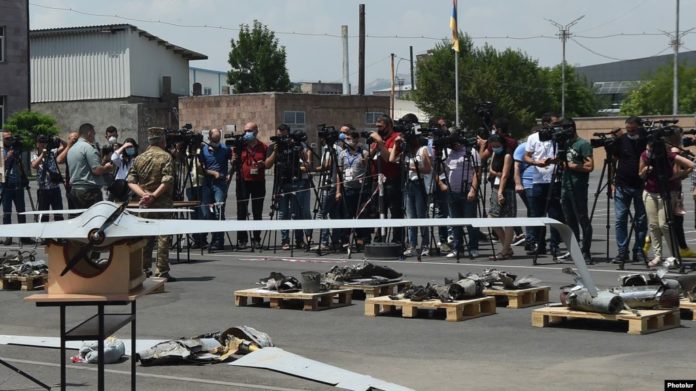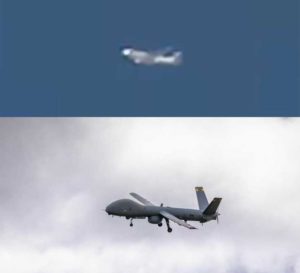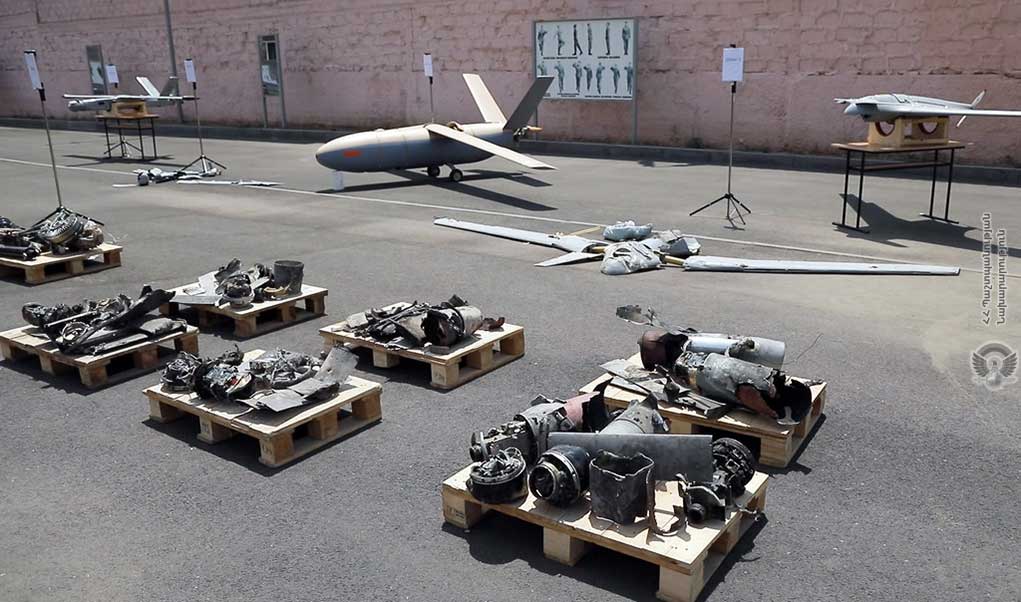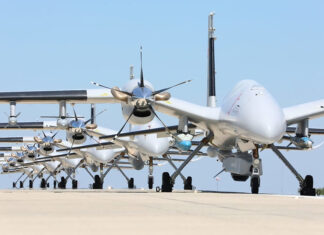

A recent flare-up in the ongoing border dispute between Armenia and Azerbaijan in the Tavush province bordering the Tovuz district in western Azerbaijan has demonstrated the growing role of unmanned aerial systems in modern warfare. At least 12 Azerbaijani servicemen, including an army general, and four Armenian soldiers died in the border clashes.
Both sides claimed downing multiple drones and loitering weapons. However, each side denied the other’s claims. Presenting visual proofs of such incidents, or debris of crashed drones would provide an undisputed proof of those claims, but in our digital age, such proofs must be taken with a grain of salt, since what you see on video and pictures may not be exact, or even close to what was real.
Take, for example, the Armenian MOD claim they have shot down 13 Azeri small tactical unmanned aerial vehicles (STUAS) and loitering weapons of different types.

They also claimed to have shot down the largest, and newest Hermes-900 strategic drone recently delivered by Israel’s Elbit Systems. Armenia provided parts of some of these drones, to substantiate its claim, but hasn’t been able to back the shooting down of the Hermes 900.
The Armenian MOD specifically identified the drone’s designation and maker. To further back their story, official sources in Yerevan released what looks like an amateur video shot with a mobile phone on-site, showing a view of the target viewed by an optical sight. The video continues with the camera zoom in on the target that looks like a fixed-wing aircraft as it ascends flying from right to left. Then, a noise of what seems to be a missile launch is heard in the background. A few seconds later, a circular effect that looks like a fireball appears, and people are cheering “we have downed it”, vapor trails can be ‘fireball’ appears over the aircraft indicating the intercept. Is that the view of real engagement?
While convincing video footage would provide proof of this claim, a fake video does the opposite. To begin with, the silhouette of the aircraft shown in the video is most likely a twin-engine, narrow-body passenger jet, not a UAS. The silhouette is definitely not the Hermes-900 Armenia claims to have shot down, since it lacks distinctive elements, such as a slender fuselage, large V tail, and a nose bulge, containing the drones’ SATCOM terminal.
Strategic UAS like Hermes 900 fly on reconnaissance missions as far as possible from the front line, in what is known as ‘standoff range’, out of the range of air defenses. Although Armenia possesses significant surface-to-air missiles such as the S-300, engagement by such assets would have been taken at a great distance from the launch site, which wouldn’t make such a visual record possible. An intercept by a closer range weapon, such as the new Armenian TorM2MK (effective 15 km would be visual, but unlikely as a Hermes 900 flying a stand-off mission would not fly into Thor’s kill zone.)
The third problem in the video is the explosion. The video shows a perfect circle done with a simple visual effect. A more convincing view would a blurred image of a terminal effect of a warhead, followed by the remains of the target descending to the ground (the Hermes typically flies above 15,000 ft, which provides plenty of opportunities to show a drone, its wings and other parts descending down in flames.)
Baku denied one of their new Hermes 900 was lost, (though evidence of other tactical drones was not denied), and we have managed to substantiate this claim with independent sources. Therefore, we tend to agree with Azerbaijan’s position that their Hermes 900s are intact. So, why did Yerevan take such a dubious act to claim something that did not happen?
Until now, Azerbaijan and Armenia maintained close to parity in the weapon systems they use against each other, the entry of advanced, strategic drones disrupt this balance, offering the Azeri side persistent coverage of the theater, operating beyond the reach of most of the Armenian air defenses. Claiming they have shot down such an asset has drawn the attention of Russian experts, that immediately arrived in Armenia for ‘preplanned air defense drills’. According to Yerevan, the purpose of these drills is to develop new methods of countering hostile UAS. Russia needs a ‘winning picture’ after their SA-22 Pantsir S mobile air defense systems have suffered humiliating defeats from Turkish drones operating in Libya in recent months.
Russian air defense units are stationed in Armenia as part of the Joint Commonwealth of Independent States (CIS) Air Defense System, a unified defense system established back in 1995 and bringing together Armenia, Belarus, Kazakhstan, Kirgizstan and Tajikistan, all former USSR states.





















